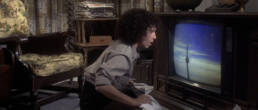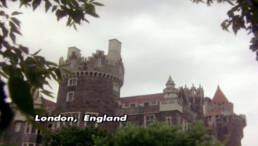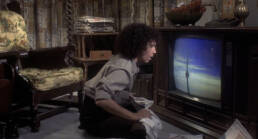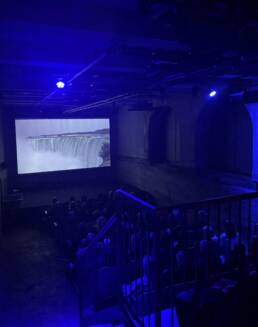Toronto is a 'Dead Ringer' in American cinema
After a sold-out premiere, encore screenings of Dave Dyment's latest film are coming to City Hall.
Oct 6, 2022
Toronto has a knack for being the stand-in for American cities in cinema. Our streets, buildings, landscapes can substitute on screen for New York, Chicago, Detroit, Philadelphia, London, even Tokyo and Mumbai. So, what does it mean to see your city reflected back to you on screen, but not your experience?
“Dead Ringer,” a feature length documentary film by Dave Dyment asks this question about the portrayal of Toronto in cinema. And more specifically, Casa Loma, its identity and film history.
After a sold-out premiere, ‘Dead Ringer’ will return for free encore screenings on Oct 7 and 16 at Toronto City Hall. Reserve your free spot here and discover more about Dave’s visionary work below.
Ontario Culture Days: The film has a focus on Casa Loma – and even had its premiere at the castle. Why focus on this site and not another recognizable location, like the CN Tower?
Dave Dyment: Casa Loma was a lens through which to look at the larger ideas in the work, and provided a structure. The film loops back to it several times, but it also features about a dozen different Toronto sites – such as the ROM, AGO, RC Harris Water Treatment facility, U of T, Bay Lower Station, Kensington Market, Yonge Street, the Scarborough Bluffs, the Waverly Hotel, etc. etc.
The CN Tower played a key role in the movie High Point, filmed two years after the tower was erected, but almost never since. As a kid I remember watching some terrible Police Academy sequel and having to rewind the VHS tape to make sure I wasn’t imagining that I spotted it in the background, where it appeared in error.
ONCD: In your research, what surprised you to learn about the castle?
DD: There are a few things in the film, such as the fact that Casa Loma housed a secret military lab during World War II, but I think the most shocking thing for me was that Henry Pellatt – who commissioned the castle and once controlled a quarter of the country’s wealth – died penniless. The rich don’t die destitute anymore, the system always finds a way to support them.
But just the creation of the castle itself is fascinating. it’s both stately and grand, and an architectural marvel, but also kind of a rich man’s folly.
ONCD: It was thrilling to watch the film premiere inside Casa Loma – like a kind of immersive cinema. What made you want to screen the work at Casa Loma?
DD: One of the offshoot projects from this piece (there have been several) was a 12 minute action film about the Hearn Generating Station, which I always regretted not trying to get shown at an event inside the Hearn itself.
Sitting in the castle’s cinema – which was originally intended to be a swimming pool – and watching a film about the castle is a big part of the project for me. Same with City Hall. Ideally, I’d love to one day screen it at all of the venues that appear.
Incidentally, Catriona Delaney at Casa Loma told me that the only person who ever swam in the Pellatt’s planned pool was Vin Diesel, while shooting the movie Pacifier there.
ONCD: So what initially inspired this project?
DD: I gave a talk to a film class in Winnipeg about a decade ago and the professor, Jonah Corne, gave me a bootleg copy of Thom Andersen’s Los Angeles Plays Itself. It’s out on Blu-ray now and probably Netflix, but at the time it was just passed around covertly among enthusiasts.
It’s an almost three hour long documentary about the way that Los Angeles has been portrayed in cinema, by itself.
I watched it three times in a row and couldn’t get it out of my head. Initially I was going to make an answer work – or an inversion – which was just about Toronto not playing itself, but eventually I wondered if footage from these American productions filmed in Toronto could be repurposed to tell Toronto stories.
ONCD: When putting the film together, how did you choose which of the city’s stories to tell?
DD: The limitations of the visuals played a big part in the selection, and several things I wanted to talk about were left out. I included these in the over one hundred footnotes on the verso of the movie poster features (posters which are available for free at Toronto City Hall. ). There are some recurring themes – such as the city’s desire to compete on the world stage, or being the inverse of San Francisco, but mostly the stories included are contested or contradicted, or involve mistaken identity and doubling, or are about cinema itself.
ONCD: When did you start this project, and how long did it take for you to create it?
DD: I’ve been researching it and collecting the clips for about a decade now, downloading and scrubbing through hundreds and hundreds of movies and TV series. I’ve amassed over 3000 scenes featuring Toronto, most of which didn’t make the edit, and will just sit dormant in an unused archive.
ONCD: 3000 scenes! Are there any you particularly regret not being able to include?
DD: The Lakeview Restaurant has hosted probably a hundred film and TV productions, and I think I’ve found most of them. Big things like Cocktail, Hairspray, and The Shape of Water, but also more obscure, smaller productions. Every time I get a new one I send it to a friend in Scotland, as we often have breakfast there together when he’s in town. He must be very sick of them filling his inbox by now.
But in the end a single longer clip functioned better than a series of shorter ones, so all of the others are omitted. That hurt a little bit. Same with Parkwood Estate, I could make an entire film about that place with the clips I have.
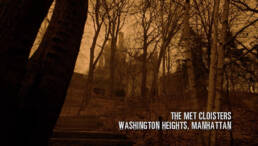

ONCD: The film is underscored by music and narration. In your creative process, how was the music selected?
DD: The music was the hardest aspect for me. If you work with a composer you can request score of a certain duration or ask for a section to be made longer or shorter. I set myself the limitation of only using music used in Toronto films, so I’d often be scrolling through hundreds of soundtrack MP3s, searching for something exactly a minute and fourteen seconds long.
Sometimes I would place in a track that matched the duration and it worked perfectly, the first time. Other instances I had to try out countless different pieces of music before it felt right. I guess there’s a balance between accepting the happenstance and trying to control the outcome.
ONCD: Your film was supported by our Creatives in Residence program, and premiered during the Ontario Culture Days Festival. How did it feel to be part of a festival’s in-person return with live audiences, since the pandemic has allowed for the reopening of cultural institutions?
DD: This work was slated to take place last year but was cancelled because of Covid, so I did some online texts and an interview with Don McKellar, in lieu of the in-person presentation. But I am personally so bored of online programming and I was very excited to watch this in situ at Casa Loma. Sitting in the dark and eating popcorn with strangers has always been one of my favourite things to do in the world.
Ontario Culture Days runs an annual Creatives in Residence program. Part of the work of the Creatives is presented during public events for our festival of free arts and culture programming across Ontario.
Meet this year’s cohort and register to attend their upcoming free events.

